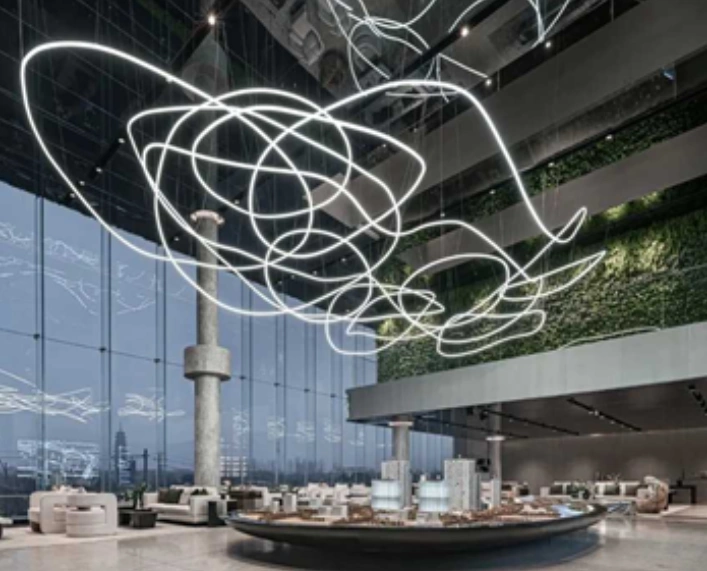Downlights vs Spotlights: When to Use Each?
When it comes to interior lighting, the choice between downlights and spotlights can significantly impact the ambiance and functionality of a space. Downlights offer a broad, diffused illumination that seamlessly blends into ceilings, making them ideal for general lighting in living rooms, kitchens, and hallways. On the other hand, spotlights excel at highlighting specific areas or objects, perfect for accentuating artwork, creating focal points in retail displays, or providing task lighting in workspaces. The decision ultimately depends on the room's purpose, the desired atmosphere, and the specific lighting needs of the space.

Grasping the Fundamentals: Downlights vs Spotlights
Defining Downlights: Characteristics and Applications
Downlights, also known as recessed lights or can lights, are fixtures installed flush with the ceiling, creating a sleek and minimalist look. These versatile luminaires project light downward in a broad beam, typically ranging from 30 to 60 degrees. The defining feature of downlights is their ability to provide even, widespread illumination without protruding from the ceiling surface.
One of the primary advantages of downlights is their ability to create a sense of spaciousness in a room. By eliminating visual clutter on the ceiling, they can make low ceilings appear higher and small rooms feel more open. This characteristic makes them particularly popular in modern and contemporary interior designs where clean lines and unobtrusive fixtures are desired.
Downlights are exceptionally versatile in their applications. They excel in providing ambient lighting for living rooms, dining areas, and bedrooms. In kitchens, they offer excellent task lighting when placed strategically over countertops and work areas. Bathrooms benefit from the even distribution of light that downlights provide, ensuring proper illumination for grooming tasks.

Spotlights: Purpose and Unique Features
Spotlights, in contrast to downlights, are designed to focus light on specific areas or objects. They typically have a narrow beam angle, often between 15 to 45 degrees, allowing for precise control over where the light is directed. This focused illumination makes spotlights ideal for accent lighting, highlighting architectural features, artwork, or display items in retail environments.
One of the key features of spotlights is their adjustability. Many spotlight fixtures can be rotated or tilted, allowing for flexibility in directing the light beam. This adaptability makes them invaluable in dynamic spaces where lighting needs may change, such as art galleries, museums, or retail stores where displays are frequently updated.
Spotlights are particularly effective in creating visual interest and depth within a space. By highlighting specific elements, they can guide the eye and create focal points in interior design. In residential settings, spotlights are often used to illuminate fireplaces, bookshelves, or to create dramatic effects on textured walls.
In commercial applications, spotlights play a crucial role in merchandise presentation. By directing focused light on products, they can enhance their visual appeal and draw customer attention. This targeted illumination is especially important in jewelry stores, fashion boutiques, and high-end retail environments where product presentation is paramount.
Choosing Between Downlights and Spotlights: Factors to Consider
Room Function and Layout
The purpose of the room and its layout are paramount when deciding between downlights and spotlights. For areas requiring uniform, general illumination, such as living rooms or open-plan offices, downlights are often the preferred choice. Their ability to provide consistent light coverage ensures that the entire space is well-lit without harsh shadows or uneven brightness.
In spaces with specific focal points or areas that require targeted illumination, spotlights come into their own. For instance, in a kitchen with an island or a dining room with a statement chandelier, spotlights can be used to highlight these features while complementing the general lighting provided by downlights.
Consider the ceiling height when making your selection. Rooms with high ceilings may benefit from the focused beam of spotlights to ensure adequate light reaches the lower levels of the space. Conversely, in rooms with lower ceilings, the discreet profile of downlights can help maintain a sense of openness.
Aesthetic Considerations and Interior Design Style
The choice between downlights and spotlights can significantly impact the overall aesthetic of a room. Downlights offer a clean, streamlined look that aligns well with modern and minimalist design styles. Their unobtrusive nature allows other design elements to take center stage, making them ideal for spaces where you want the lighting to blend seamlessly into the background.
Spotlights, on the other hand, can become a design feature in their own right. Track lighting systems with multiple spotlights can add an industrial or contemporary flair to a space. In more traditional interiors, carefully placed spotlights can accentuate architectural details or highlight prized possessions, adding depth and character to the room.
Consider the color temperature of the lights in relation to your interior design. Warm white light (2700K-3000K) can create a cozy, inviting atmosphere, while cooler temperatures (4000K-6500K) can enhance the crispness of modern interiors or improve visibility in task-oriented spaces.
Energy Efficiency and Maintenance
Both downlights and spotlights are available with energy-efficient LED options, but their energy consumption can vary based on usage patterns. Downlights, often used for general lighting, may be on for longer periods, making their efficiency crucial for long-term energy savings. Look for downlights with high lumens per watt ratings to ensure maximum efficiency.
Spotlights, typically used for accent lighting, may be on for shorter durations but still benefit from LED technology for longevity and reduced energy consumption. When selecting spotlights, consider options with adjustable beam angles or dimmable features to maximize their versatility and energy efficiency.
Maintenance is another factor to consider. Recessed downlights can be more challenging to access for bulb changes or repairs, especially in high ceilings. However, with the long lifespan of LED technology, this becomes less of a concern. Spotlights, particularly those in track systems, often offer easier access for maintenance and adjustments.

Innovative Applications: Combining Downlights and Spotlights
Creating Layered Lighting Schemes
The most effective lighting designs often incorporate both downlights and spotlights to create a layered lighting scheme. This approach combines ambient, task, and accent lighting to achieve a balanced and functional illumination that enhances the space's aesthetics and usability.
In a living room, for example, downlights can provide the base layer of ambient lighting, ensuring even illumination throughout the space. Spotlights can then be strategically placed to highlight artwork on the walls, illuminate bookshelves, or create a cozy reading nook. This combination allows for flexibility in creating different moods and atmospheres within the same space.
Smart Lighting Integration
The advent of smart lighting technology has revolutionized the way we use both downlights and spotlights. By integrating these fixtures into a smart home system, users can control the intensity, color temperature, and even the direction of light (in the case of motorized spotlights) through smartphone apps or voice commands.
Smart downlights can be programmed to adjust their brightness and color temperature throughout the day, mimicking natural light patterns and potentially improving occupants' circadian rhythms and overall well-being. This feature is particularly valuable in spaces with limited natural light.
For spotlights, smart technology enables dynamic lighting scenes. In a gallery or retail setting, spotlights can be programmed to change focus or intensity based on the time of day or specific events, creating an ever-changing and engaging environment for visitors.
Conclusion
The choice between downlights and spotlights is not always an either/or decision. Often, the most effective lighting solutions incorporate both types to create a versatile and dynamic lighting environment. Downlights excel in providing consistent, general illumination that forms the foundation of a room's lighting scheme. Spotlights offer the precision and flexibility needed to highlight specific features, create focal points, and add depth to the space.
For expert advice on selecting the right combination of downlights and spotlights for your specific needs, or to explore the latest in LED lighting technology, don't hesitate to reach out to our team at USKYLED. Contact us at sales@uskyled.com to discover how we can illuminate your space with style and efficiency.
References
1. Smith, J. (2023). "The Art of Interior Lighting: Downlights vs Spotlights". Architectural Lighting Magazine, 45(3), 28-35.
2. Johnson, E. & Brown, L. (2022). "Energy Efficiency in Modern Lighting Solutions". Journal of Sustainable Design, 17(2), 112-124.
3. Lee, S. (2021). "Retail Lighting Strategies: Enhancing Product Presentation". International Journal of Retail & Distribution Management, 49(4), 401-415.
4. Williams, R. (2023). "Smart Lighting: Revolutionizing Home and Commercial Spaces". IoT Technology Review, 8(1), 56-69.
5. Garcia, M. & Taylor, K. (2022). "Layered Lighting Design: Combining Functionality and Aesthetics". Lighting Research & Technology, 54(6), 789-802.

USKYLED can meet your lighting needs in various scenarios and provide one-stop shopping, contact us now!

Why You Should Choose USKYLED?
Popular Blogs